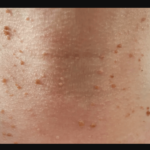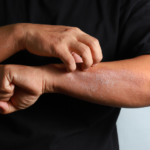Bacterial skin infections are a common problem that affects millions of people every year. These infections can be caused by a variety of different bacteria, and they can range in severity from mild to life-threatening. Some of the most common bacterial skin infections include cellulitis, impetigo, and folliculitis.
Cellulitis is a bacterial infection that affects the deeper layers of the skin and subcutaneous tissues. It is typically caused by the bacteria Streptococcus pyogenes or Staphylococcus aureus, and it can result in redness, swelling, and warmth in the affected area. Impetigo, on the other hand, is a highly contagious bacterial skin infection that is caused by either Staphylococcus aureus or Streptococcus pyogenes. It is characterized by the appearance of small, fluid-filled blisters that burst and form a yellowish crust.
Folliculitis is another common bacterial skin infection that affects the hair follicles. It is typically caused by Staphylococcus aureus, and it can result in tiny, red bumps around the hair follicles. While most bacterial skin infections can be treated with antibiotics, it is important to seek medical attention if you suspect that you have an infection. Left untreated, these infections can lead to severe complications and even death in some cases.
Types of Common Bacterial Skin Infections

Bacterial skin infections are caused by various bacteria and can affect people of all ages. Here are some of the most common types of bacterial skin infections:
- Impetigo: This is a highly contagious bacterial skin infection that typically affects children. It is characterized by red sores that develop into blisters and then crust over. Impetigo is caused by either Staphylococcus aureus or Streptococcus pyogenes bacteria.
- Cellulitis: This is a bacterial skin infection that affects the deeper layers of the skin and the subcutaneous tissues. It is usually caused by Streptococcus or Staphylococcus bacteria and can occur anywhere on the body. Symptoms include redness, swelling, and warmth in the affected area.
- Folliculitis: This is an infection of the hair follicles that can occur anywhere on the body. It is caused by bacteria, such as Staphylococcus aureus, and can cause small, red bumps or pimples to form around hair follicles.
- Boils: Also known as furuncles, boils are caused by Staphylococcus aureus bacteria and typically occur on the face, neck, armpits, and buttocks. They start as a red, tender bump and eventually fill with pus and develop a white or yellow center.
- Staphylococcal Scalded Skin Syndrome (SSSS): This is a rare bacterial skin infection that is caused by Staphylococcus aureus bacteria. It is most common in young children and in infants and is characterized by a red rash that looks like a burn or scald.
It is essential to seek medical attention if you suspect you have a bacterial skin infection. Your healthcare provider can diagnose the infection and prescribe the appropriate treatment, which may include antibiotics or other medications.
Causes of Common Bacterial Skin Infections
Bacterial skin infections are caused by a variety of bacteria that can enter the skin through cuts, scrapes, insect bites, or other openings in the skin. Some of the most common bacteria that cause skin infections include:
- Staphylococcus aureus (staph)
- Streptococcus pyogenes (strep)
- Pseudomonas aeruginosa
- Escherichia coli (E. coli)
- Haemophilus influenzae
These bacteria can cause infections ranging from mild to severe, depending on the type of bacteria and the person’s overall health. People with weakened immune systems, such as those with diabetes, HIV/AIDS, or cancer, are more susceptible to bacterial skin infections.
Other factors that can increase the risk of bacterial skin infections include poor hygiene, crowded living conditions, and exposure to contaminated water or soil. Certain activities, such as contact sports or sharing personal items like towels or razors, can also increase the risk of infection.
It’s important to note that not all skin infections are caused by bacteria. Fungal infections, viral infections, and parasitic infections can also affect the skin. However, bacterial infections are among the most common and can be easily prevented with good hygiene practices and prompt treatment of cuts and scrapes.
Symptoms of Common Bacterial Skin Infections

Bacterial skin infections can cause a range of symptoms, depending on the type of infection and how severe it is. Here are some common symptoms of bacterial skin infections:
- Redness: The infected area may appear red or pink, and the redness may spread beyond the initial site of infection.
- Swelling: Swelling may occur around the infected area, making it feel tender or painful to the touch.
- Blisters: Some bacterial infections can cause blisters to form on the skin, which may be filled with pus or other fluids.
- Crusting: As the infection progresses, the skin may begin to crust over or develop scabs.
- Itching: Itching is a common symptom of many skin infections, and can be mild or severe.
- Fever: In some cases, a bacterial skin infection can cause a fever or other systemic symptoms, such as fatigue or muscle aches.
If you notice any of these symptoms, it is important to seek medical attention right away. Bacterial skin infections can be serious if left untreated, and may require antibiotics or other medical treatment to clear up.
Diagnosis of Common Bacterial Skin Infections
Diagnosing bacterial skin infections can be challenging, as many of the symptoms overlap with other skin conditions. In order to properly diagnose a bacterial skin infection, a healthcare provider will typically perform a physical examination of the affected area and may take a sample of the skin for laboratory testing.
During the physical examination, the healthcare provider will look for signs of infection, such as redness, swelling, and pus-filled blisters. They may also ask the patient about their medical history and any other symptoms they may be experiencing.
If the healthcare provider suspects a bacterial skin infection, they may take a sample of the affected skin for laboratory testing. This may involve swabbing the skin or taking a small biopsy. The sample is then sent to a laboratory to be analyzed for the presence of bacteria.
It is important to note that not all bacterial skin infections require laboratory testing. In some cases, a healthcare provider may be able to diagnose the infection based on the physical examination alone. However, laboratory testing can be helpful in determining the specific type of bacteria causing the infection and guiding treatment.
Treatment of Common Bacterial Skin Infections
When it comes to treating bacterial skin infections, it is important to identify the specific type of bacteria causing the infection. This can be done through a culture and sensitivity test, which will determine the most effective antibiotic for treatment.
Antibiotics are the primary treatment for bacterial skin infections. Topical antibiotics, such as mupirocin and retapamulin, are often prescribed for mild infections, while oral antibiotics, such as cephalexin and doxycycline, are used for more severe infections.
In addition to antibiotics, other treatments may be recommended to help manage symptoms and promote healing. These may include:
- Warm compresses to reduce inflammation and promote drainage of pus
- Pain relievers, such as acetaminophen or ibuprofen, to manage discomfort
- Topical antiseptics, such as chlorhexidine or povidone-iodine, to help prevent secondary infections
- Topical corticosteroids to reduce inflammation and itching
It is important to follow the full course of treatment as prescribed by a healthcare provider, even if symptoms improve before the medication is finished. Failure to complete the full course of antibiotics can lead to the development of antibiotic-resistant bacteria.
In some cases, surgical intervention may be necessary to drain abscesses or remove infected tissue. This is typically reserved for more severe infections that do not respond to other treatments.
Overall, prompt and appropriate treatment is essential for the management of bacterial skin infections. If left untreated, these infections can spread and lead to serious complications.
Prevention of Common Bacterial Skin Infections
Bacterial skin infections can be prevented by following some simple guidelines. Here are some tips:
- Wash your hands regularly with soap and water, especially before eating and after using the toilet.
- Keep your skin clean and dry. Take a shower or bath daily, and use a clean towel to dry off.
- Avoid sharing personal items such as towels, razors, and clothing with others.
- Wear protective clothing, such as gloves and long-sleeved shirts, when working with animals or handling soil.
- Keep cuts and scrapes clean and covered with a bandage until they are healed.
- Avoid touching your face or other people’s faces with your hands.
- Do not pick at scabs or sores on your skin.
- Stay away from people who have skin infections or open wounds.
By following these simple guidelines, you can reduce your risk of developing a bacterial skin infection. If you do develop an infection, seek medical attention promptly to prevent it from spreading and causing more serious health problems.



![Hot Spoon Mosquito Bite Treatment [Does It Help and How To] hot spoon mosquito bite](https://skincaregeeks.com/wp-content/uploads/2021/05/hot-spoon-mosquito-bite-150x150.jpg)
![Shades of Brown Skin [20 Common Brown Shades with Chart] shades of brown skin tone](https://skincaregeeks.com/wp-content/uploads/2021/05/shades-of-brown-skin-tone-150x150.jpg)
![Neutral Skin Tone Defined [and Best Colors for Neutral Skin] neutral skin tone](https://skincaregeeks.com/wp-content/uploads/2021/05/neutral-skin-tone-150x150.png)



